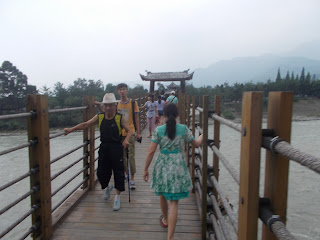I was impressed from very early on by all the cats I saw in Chengdu. Many of them very tough looking street characters. They typically ignored me. Not timid like my own cat, they were very independent creatures. At the bottom, is a Cat Cafe. I know what you are thinking but this was a place that had cats just wandering around. They were mostly sleeping or lounging in baskets in the front. Patrons could pick them up and take them in their laps if they liked. Tea and light food was available.At top is a real warrior who I think may have been the mother of the next cat who I found sleeping in a nearby planter. These two were outside a restaurant I frequented and, given the dishes of food and water, had been befriended by the waiters and waitresses.
Wednesday, August 28, 2013
Sunday, August 25, 2013
Ear picking
During the trip to the irrigation site, we encountered a professional ear picker and he and we convinced one of the students to be the victim. The patient reported that it tickled more than hurt.
Trousers tell a tale...
The photo at top is perhaps one of those uses of English that leave English speakers puzzled. Found in a museum of Hakka artifacts, I suspect they are suggesting that perhaps Hakka people rode horses a lot and needed appropriate pants. But your guess is as good as mine. Below are some Hakka books and handicrafts.
Hakka community
Not far from Chengdu was a community of people of an historic ethnic minority, the Hakka people. There are various theories about the origins and movements of the Hakka over thousands of years but, to simplify, they are related to the Han Chinese (the dominant Chinese group) and moved into the Sichuan area during the reign of the Emperor Kang-hsi (1662-1722)to escape flooding in southern coastal areas. They have a unique language, customs and architecture. At top is me standing on the main street; at bottom, one of the most prominent pagodas; a wall in the central area with a great dragon; the bottom three photos are of a birthday parade, at top, is the guest of honor being wheeled a long, then followed by family members, and then a traditional band.
Friday, August 16, 2013
My neighborhood - Yulin
I lived in the Yulin neighborhood near the university. It is a popular neighborhood for expats and for professional people mainly because of the large number of shops and restaurants in the area.
At top, in addition to the regular shops, there were always street vendors pedaling their wars through the neighborhood in these carts. Mostly women, you can see one selling melons. Next, a cart a man was pedaling selling a variety of things, including hats. Next, is the bakery where I shopped a lot right next door to my building. Great croissants. Next is shop selling chocolates and snacks. Next, a couple of women with food carts have stopped to talk with each other. I have been amused by some of the signs. You can see this next sign reads "Three Gun Living Concept" for a clothing store. At bottom is one that reads "Kissyourface" for a sort of hair and makeup store. I've been told that since most of the Chinese cannot read English that English is used more as a decoration and also implies that there is quality merchandise sold there. Next is a street scene showing several stores. You can read "Hongchi chain store." These stores, of different sizes, were all over the city. Next is a food shop where the owner conducted most of her business just out on the sidewalk.
Friday, August 9, 2013
What does Chengdu look like? Part II
Chengdu has several very large commercial areas. At top, is a place near the central square, next is really the downtown area, then a place near my part of town and close to the US consulate, then another commerical area near Sichuan University, and, at bottom, a place on the northern side of the city, showing a subway entrance that is very close to the oldest and largest Buddhist temple in the city.
What does Chengdu look like?
This is a hard question to answer. It is a rolling mixture of new and old, fresh and worn out. One thing overall I think I am impressed with is the apparent dynamism of the economy. The right-wing in America is absolutely determined to argue that there is a link between capitalism and democracy. And yet China disproves that.
I'm presenting here a series of huge apartment blocks that are everywhere - a clear effort to provide housing for the 12 million or so who live in the Chendu metro.
I'm presenting here a series of huge apartment blocks that are everywhere - a clear effort to provide housing for the 12 million or so who live in the Chendu metro.
""Treasure of Sichuan" - an ancient irrigation project
Sometimes called the "Treasure of Sichuan," an irrigation project created 2,000 years still provides the region with water for both urban and agricultural uses.
Built in 256 BC by the Qin Kingdom during the Warring States Period, the project diversts part of the Minjian River to irrigate over 5,300 square kilometers of agricultural land near Chengdu.
Known as the Dujiangyan project, it takes it name from the nearby ancient city which has been redeveloped for tourism and recreation. The grounds of the site are filled with temples and shops and parks. A wonderful place to escape from the hectic pace of Chengdu.
Subscribe to:
Comments (Atom)



















































